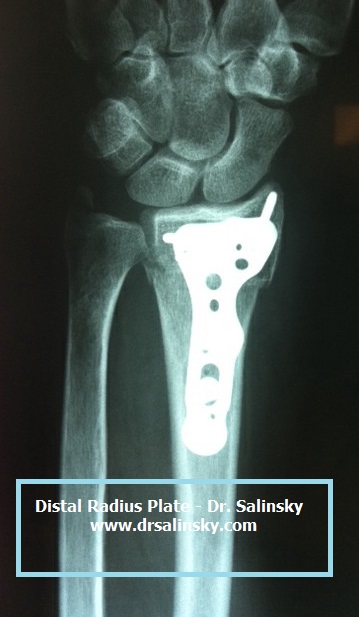Distal Radius Fractures
Distal radius fractures (wrist) are among the most commonly diagnosed fractures in  orthopedics and usually occur from a fall on an outstretched hand. Historically they were called Colle’s fracture named after a patriarch in orthopedic surgery. Children and the elderly make up the two greatest populations of people that encounter this painful injury, but they are treated very differently. Surgery is not always necessary; it will depend on the fracture pattern, medical condition of the patient, and of course patient expectations. Sometimes a distal radius fracture is accompanied by a fracture of the ulna.
orthopedics and usually occur from a fall on an outstretched hand. Historically they were called Colle’s fracture named after a patriarch in orthopedic surgery. Children and the elderly make up the two greatest populations of people that encounter this painful injury, but they are treated very differently. Surgery is not always necessary; it will depend on the fracture pattern, medical condition of the patient, and of course patient expectations. Sometimes a distal radius fracture is accompanied by a fracture of the ulna.
In children a distal radius fracture usually involves the growth plate. The classification of the severity of these injuries was named after doctors Salter and Harris and range from 1 to 8. Most however are grade 1 or 2 and rarely affect the growth of the bone after the fracture heals. If they are displaced they need to be reduced (put back into place) with 24 to 48 hours and sometimes need to held with pins or wires. This would be done in an outpatient surgery center. All will need a cast for about 6 weeks; usually for the first 3 weeks the cast will have to go all the way up to the armpit! Then the final 3 weeks will only require a cast that goes up the forearm. But the kids can at least pick whatever color cast they want!
Adult distal radius fractures need surgical fixation more often than their pediatric counterpart. There are certain angles that need to be as perfect as possible to give the patient the best chance of normal motion. Similarly, if these angles are not precise then future arthritis is more likely. Sometimes these fractures involve the ulna shaft, or just the tip of the ulna. This or course makes the fracture more severe and healing times may vary. Also, if the fracture goes into the joint healing is prolonged and results usually worsen because arthritis is more imminent.
Some of these fractures can be casted for about 6 weeks, but those than need surgery require a metal device of some kind to hold the bones in place. This can be done with wires, external fixators, internal plates, or a combination thereof. Plates are most frequently used nowadays because of their improved design and instrumentation. This surgery is done in an outpatient surgery center and usually takes as little as 30 minutes, but can sometimes take up to 60 minutes. The scar is on the bottom of the wrist and is usually well tolerated

